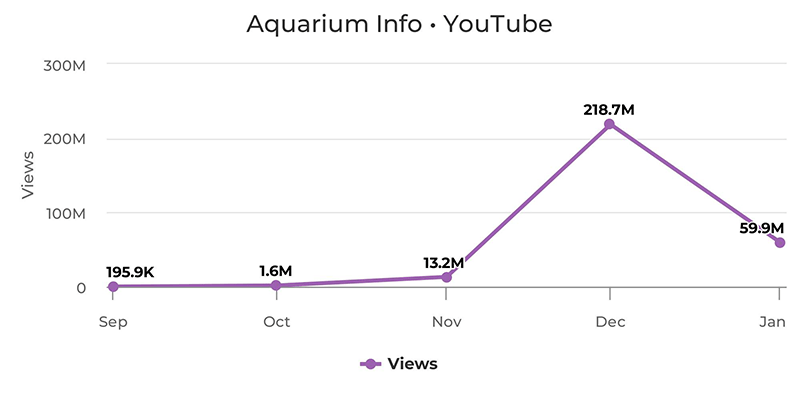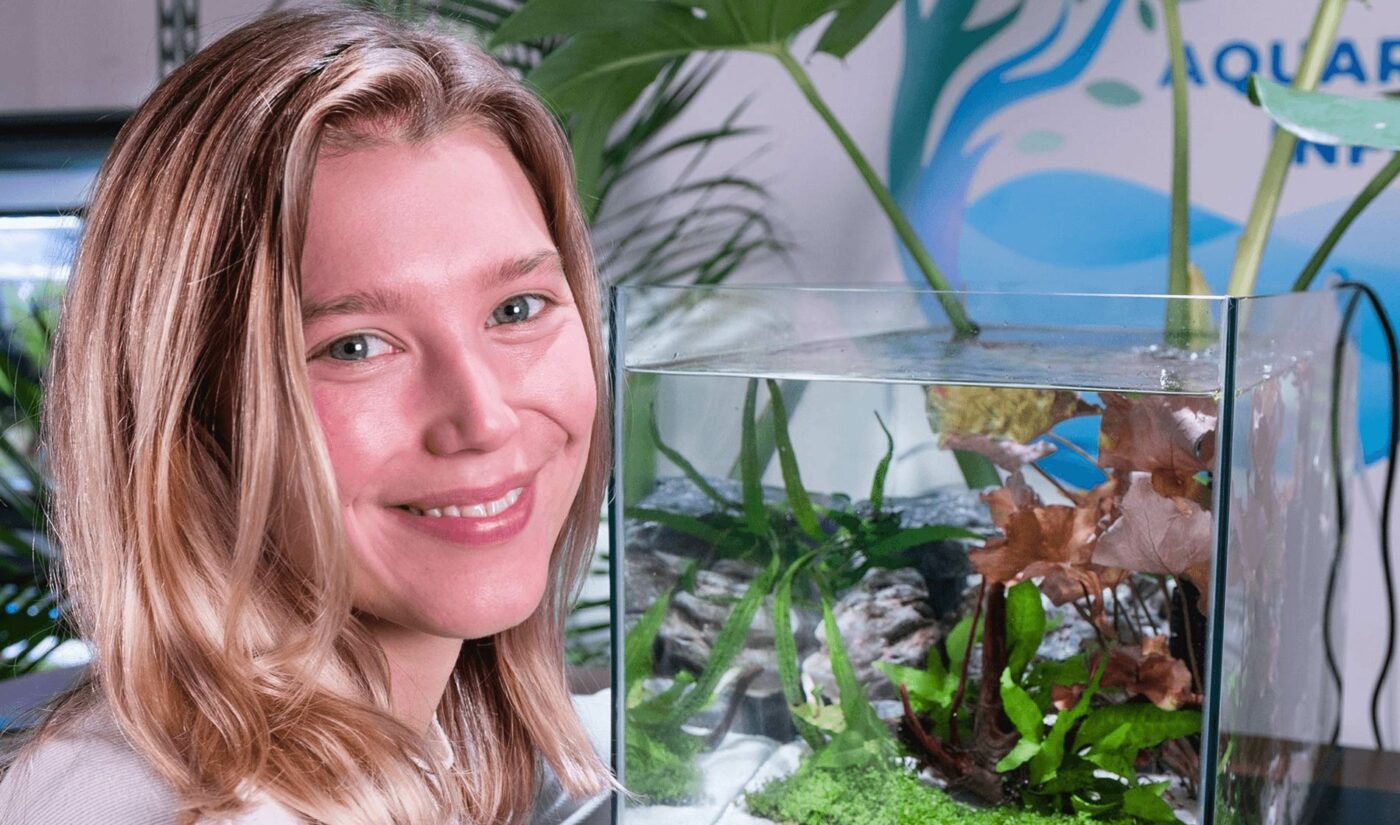Welcome to Creators on the Rise, where—in partnership with global creator company Jellysmack—we find and profile breakout creators who are in the midst of extraordinary growth.
As a kid, Jamie Dalton wasn’t allowed to have a cat or dog.
But that doesn’t mean her childhood home was petless. Instead of bringing home fuzzy companions, Dalton’s mother stocked the house with what Dalton affectionately calls “wetpets.” The family had a 75-gallon tank they all shared, and Dalton also kept her own bettas.

Subscribe for daily Tubefilter Top Stories
While all of her family’s wetpets helped spark her interest in fishkeeping, it was Dalton’s bettas that started her on the path to founding her blog Aquarium Info. For those unfamiliar, bettas (aka Siamese fighting fish) are small, beautiful freshwater fish known for their flowing fins and vast variety of colorations. And they are also unfortunately, erroneously “known” as minimal-care starter fish that can be kept in little half-gallon desktop bowls. As Dalton and any other responsible fishkeeper would tell you, bettas need much more than half a gallon of room, and also need filtered, heated water like any other tropical fish.
The more involved Dalton got in fishkeeping, the more she realized she wanted to share this kind of vital information with other aquarists–especially beginners. So, in 2015, she launched Aquarium Info.
Then, during the pandemic, she took Aquarium Info to YouTube.
Like many of our other Creators on the Rise featurees, Dalton found herself looking for something to do during lockdowns. She decided to try making videos about her tanks, and found they were a good “creative outlet,” she says. Soon she began sharing a mix of long-form and short-form educational videos on YouTube, covering starter essentials like scaping a new tank and setting up a bowl that’s actually healthy for a betta and establishing a planted environment. One of her first videos to take off was a three-minute upload about the process of making an underwater cave-themed tank. Dalton posted that in February 2021, and to date it’s received around half a million views.
Half a million is nothing to sneeze at, but it’s also nothing compared to the views her channel is getting now.
After posting videos throughout 2021, Dalton doubled down in December and posted one new video to YouTube Shorts every single day. It paid off instantly: her channel soared from 1.6 million views in October and 13.2 million in November to 218 million in December, with videos about trendy fishkeeping techniques and Dalton’s pet axolotl bringing in tens of millions of views. Her subscriber count, meanwhile, grew from 36,000 at the end of November to, now, more than 410,000.

Don’t let that supposed “dip” in January 2022 fool you–we’re including that to show Dalton has already reached 60 million views in the first 12 days of this month. Monthly view and subscriber data from Gospel Stats.
Her YouTube channel’s growth has let Dalton share vital fishkeeping information with millions of people. And thanks to her audience there, she’s now also providing the tools they need to act on that information.
In October 2021, Dalton launched her own business. Called Wetpets, the digital shop vends from-the-ground-up tank kits, from a “nano” 2.4-gallon tank up to a “MAXX+” 16-gallon tank. Each kit comes with a rimless glass tank, white sand, seiryu stone, and medical-grade aquascaping tools–all the things viewers will see Dalton using in her videos. The store links out to other items Dalton suggests purchasing, like filters, lighting, and heaters.
Dalton hand-picks kit ingredients herself, and package and ships them in between working a full-time job at a tech company and creating content on YouTube and TikTok (where she has 1.4 million followers).
For now, she’ll continue balancing her job, content creation, and Wetpets. She’s expanding her YouTube team to include another editor, and hopes to see her channel hit 10 million subscribers. A number like that used to be unthinkable for a “fish channel,” she says, but nowadays? “I think anything is possible!”
Check out our chat with her below.
Tubefilter: Tell us a little about you! We saw that you started keeping fish as a kid, because your mom preferred them to other pets. How did you end up becoming so passionate about keeping aquatic pets? What about them really appeals to you?
Jamie Dalton: Hello! Thank you so much for taking the time to chat with me.
My name is Jamie and I love aquascaping. I grew up in the Chicago suburbs with my mom and four sisters. As a kid, we kept many different critters. Among them was a 75-gallon freshwater fish tank with koi, goldfish, and a few algae eaters. I always found the tank peaceful and entertaining. I remember coming home after stressful days of school and sitting and watching the fish swim around. I also had several betta fish growing up.
The biggest appeal of keeping wetpets is that they’re easier to care for and bring just as much joy as a furry friend. I love watching fish display their natural behaviors and find the hobby to be therapeutic. Fun fact: It’s been proven that keeping fish improves mental health and also helps to reduce anxiety!
Tubefilter: In 2015, you launched your blog Aquarium Info. Why was it important for you to educate other people about caring for their own fish and other aquatic pets?
JD: As a fishkeeper, you spend hours doing research on the aquarium hobby. From creating the best tank setup for its inhabitants to general maintenance to fish healthcare, the list goes on and on. There is so much to know, and it can be extremely overwhelming!
I wanted to create a place with an abundance of resources and foster a community for fishkeepers. It’s always been important to me that fishkeeping information is easy, accessible, and community-driven.
Tubefilter: You started making videos during the pandemic. Why then? Did it just seem like the “right time,” were you stuck at home and needed something to do…?
JD: Bingo! I’ve been keeping fish since I was a kid, but only recently began filming my creations and sharing them with the world. Creating videos during the pandemic gave me a creative outlet, and I’m so thankful for the community it has created.
Tubefilter: Why did you choose YouTube as the platform to share your videos and information?
JD: I’ve always loved YouTube as a viewer and think it has an incredible creator community. The subscribers on YouTube seem to be more loyal, positive, and appreciative of content than you find on other platforms. YouTube also has a community that enjoys longer-form content.
In addition, there is searchable content, which is great for evergreen videos aimed to inform a viewer on a specific subject. Viewers either come to YouTube to answer a specific question or to sit back and enjoy a story. This really resonated with me, as I love making both of these styles of content. It’s fulfilling to make an educational video rather than attempting a viral hit every week.
Tubefilter: Your YouTube channel has recently seen a big boost in number of views and subscribers. Do you know if there was one specific video that took off, or did numbers go up across a bunch of videos simultaneously?
JD: Prior to experiencing success with Shorts, I had a number of long-form videos grow quite well organically. The majority of my views came from an axolotl video and an underground cave build. I was very fortunate to have a following on Facebook, Instagram, and TikTok that helped grow my channel from its inception and sped up getting those first (and, in my opinion, the most difficult) 1,000 subscribers. I feel that getting off the ground is the toughest challenge for any YouTuber. I wouldn’t discount using other platforms to funnel enthusiastic viewers to your long-form content!
More recently, I had success using Shorts, but there wasn’t one specific video that took off. In fact, it was some of the older Shorts that received the most views. I had been posting Shorts for almost six months before the algorithm picked them up and started getting them in front of viewers! I would recommend delaying your gratification and posting great-quality short-form content, regardless of how many views it gets in the first few days.
Tubefilter: We see you make a mix of short and midlength content, and often condense your midlength videos to make Shorts from them, too. What role has Shorts played in the growth of your channel?
JD: I attribute the recent growth of my channel primarily to Shorts. Short-form video is something I was already familiar with from TikTok, so I decided to go all in on short-form content on YouTube. I posted a Short nearly every day in the month of December and experienced strong growth. Shortening longer videos into Shorts is a brilliant strategy. It takes considerable time to cut older videos down, but it’s well worth the effort. You’d be surprised at how engaging a 40-second edit from a three-minute video can be. I do struggle to get any sort of “story arc” into the shorter versions, but it is something I am working on every day.
Tubefilter: As you mentioned, you’re also on TikTok. Did you start there before or after you launched a YouTube channel? Do you notice any difference between the two platforms in terms of audience growth, what videos/topics are better received…?
JD: I created my TikTok after launching my YouTube channel. I’ve definitely seen a correlation between video performance and social platforms, meaning if a video performs well on TikTok, it will likely perform well on YouTube, and vice-versa.
However, although TikTok does allow three-minute videos on its platform, they don’t perform well. The short attention span of the audience means it is difficult to create longer-form content. This also makes building a brand or audience much more difficult. It can be frustrating, as educational, or more informative, content generally has to be stripped down in favor of viral content if you want to see your video perform well.
Tubefilter: Also during the pandemic, you launched Wetpets, a shop selling the ultramodern, sleek aquarium kits you use in your videos. When did the idea to start Wetpets come along? Was it before or after you started making videos?
JD: The idea for launching Wetpets came after I started creating video content. My audience was eager to learn more about fish and what it takes to join the hobby. I wanted to create a product that would make aquascaping and fishkeeping fun, simple, and also an added element of design in your home.
It actually took months to source the highest quality materials for my products! I had a strict acceptance criteria and wanted to ensure the products I was releasing were the best on the market. A kit for fishkeepers, by fishkeepers! Wetpets brings me so much joy–I love hand-picking and packing orders for my customers!
Tubefilter: Are Aquarium Info and Wetpets your full-time jobs? What else do you get up to? What does the average day look like for you?
JD: Hopefully someday. 🤞
Currently, I work full-time at a tech company. On an average day, I pick and pack orders in the morning, work during the day, and ship orders, film, and edit at night. In my downtime, I love to get outdoors (I’m a huge walker), travel, enjoy live music, and read.
Tubefilter: Has your recent engagement spike on YouTube changed anything for you? Do you have any new plans or goals for your channel?
JD: Yes, absolutely. There is evidently a strong, current demand for short-form content across social platforms. It is clear that it is here to stay and is continuing to grow rapidly. I plan to continue to release more short-form videos in tandem with longer-form videos in 2022. I think we will see an extensive number of changes to short-form content this year; it is truly in its infancy.
Generally, advertisers follow engagement and watch-time. An example of this would be multiple Reels being watched in quick succession leading to a combined watch time that may be longer than a single video and, therefore, reach a wider audience. This could be a winning strategy. But who knows!
Tubefilter: Do you have anyone else working with you behind the scenes at Aquarium Info, like an editor or manager?
JD: Yes! I work with a very talented filmmaker to bring my videos to life and brainstorm ideas for videos, Shorts, and content in general. I couldn’t do it without him! Shameless plug: We’re looking to add another editor to our team, so if you’re interested, hit me up!
Tubefilter: What’s your favorite thing about making content so far?
JD: I adore the community that Aquarium Info has created. It’s always been my goal to create a place for people to get their questions answered, and this platform has allowed me to do just that. Aquariums are an extremely intimidating undertaking when they really shouldn’t be. They are truly rewarding and, armed with the correct information, a lot of fun.
Tubefilter: What’s next in the immediate future for you and your channel? Where do you see yourself in five years?
JD: It’s my goal to make it to one million subscribers and, following that, 10 million subscribers.
This will not be an easy feat! Fortunately, YouTube has meritocracy at its core. If you have a video camera and a computer, work hard enough and work smart enough, the odds are highly in your favor. Just five years ago, a fish channel with 10 million subscribers would seem completely absurd. But in 2022? I think anything is possible!
 Jellysmack is the global creator company that detects and develops the world’s most talented video creators. The company’s proprietary video optimization technology and data drive social audience growth, unlocking new revenue streams and amplifying monetization.
Jellysmack is the global creator company that detects and develops the world’s most talented video creators. The company’s proprietary video optimization technology and data drive social audience growth, unlocking new revenue streams and amplifying monetization.
Currently home to over 150 influential Creators including PewDiePie, MrBeast, Brad Mondo, and Bailey Sarian, Jellysmack optimizes, operates, and distributes creator-made video content to Facebook, Instagram, Snapchat, TikTok, Twitter, and YouTube. Jellysmack-managed content boasts 10 billion global monthly video views and a cross-platform reach of 125 million unique U.S. users, making it the largest U.S. digital-first company in monthly social media viewers.
Looking to grow your social presence? Let’s talk.








